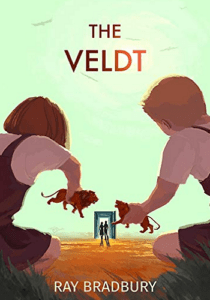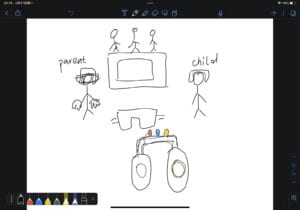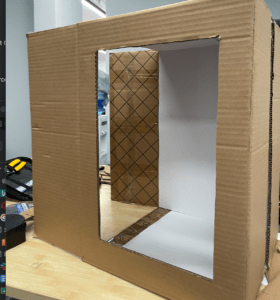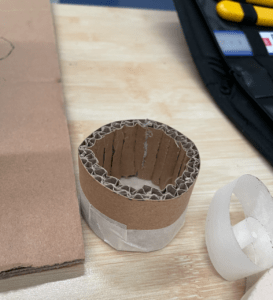Mind-Reading TV
Step 1. Brainstorming
When our group was first tasked with creating interactive artifacts inspired by 3 stories: The Veldt, The Ones Who Walk Away from Omelas, and The Plaque, we all agreed to design an artifact inspired by The Veldt by Ray Bradbury. The common reason for this is that we all had striking memories of the story, including the parents of children being eaten by lions in a virtual reality room called the “nursery.”

Next, we tried to discuss the definition of interactive artifacts, which means that they must be communication between people or reactions between things working together. We also agreed that the evidence of communication with others would be high audience participation. So before creating interactive artifacts, we mainly considered 2 components: Relevance to the chosen story and communicability with the audience. With this in mind, we created our initial idea sketch.

Our first idea was to develop mind readers TV, glasses, and headphones. I suggested the TV because I was considering the story of The Veldt. The parents in the household are killed by lions because they are in the “nursery”, a virtual reality room. This room can create any virtual reality that people imagine. Although the parents recognized the nursery, they were so fascinated by the fully automated house that they did not recognize the danger. So I thought about how to reduce the underlying danger and keep people happy with their lives in the world in The Veldt story. I started looking at things around me, thinking that something you have never seen before can reduce audience engagement. And I thought that changing the channel to TV and changing the environment in the nursery were similar. So I decided to mix two things. Fortunately, when I proposed this idea, my teammate thought it was a good idea, so we decided to develop a mind reader TV that has the function of creating anything the audience wants and imagines. The other teammates suggested mind-reading glasses and headphones create the medium to read people’s minds.
Step 2. Building Process
1) Creating TV
First we create the basic shape of TV with the cardboard. Then with the cutter knife we cut out one side of the cardboard to create the screen part. We also cut out the bottom part to fit the objects we want to put in our artifacts. After that, we covered the inner part with white paper, not only to highlight the object coming out of our artifact, but also to look more realistic, since the inner part was messy. In this part, I contribute to cut out the screen part.

Next, we made buttons for our TV. First, we made three different colored buttons. We cut them out with a cutter knife in a square shape and colored them red, green, and purple. A red button means the machine is broken, a green button means it is working fine, and a purple button means it is ready to use. Then we made the button that we can turn. It is functioned to show the imagined object on the website TV. To make this button, we cut out a large strand and a small strand. Then we made a cut in these strands so that the cardboard is rolled without breaking. And we glued the edges so it would stay rolled. Then we attached the big rolled strands to the small rolled strands. When all the buttons were ready, we attached them to the TV.

2) Creating Headphones

To make the top part of the headphones out of cardboard, we cut out a large and wide strip of cardboard. And cut out the same buttons used for TV to show the audience that these two objects are connected. For the ear part, we cut out two circles big enough to cover our ears, and two long strips to put around the circles to make them three-dimensional. Since we need to run the strands around the circles, we made several cutouts so they can be rolled. Then we cut out two long strands so we can attach the ear piece and the top part of the headphones.

In the end, we decide to wrap the ear parts with black tape to make them look more realistic. We also decide to add a headphone stand at TV.


This is what our final artifact looked like.

Step 3. Prepare for the performance
<Script>
Yuni: I’m so hungry, I wish I can have a hamburger right now. Oh right! I forgot about the mind-reading machine. (Use machine)
Peirong: Oh today is so hot! I wish I can drink some water. Let me use this mind-reading TV! (Use machine)
Malaine: Today is pretty chilly, I should have brought my jacket! There is mind-reading TV right over there. I’m so lucky. (Use machine)
Yuni: Today is my birthday! I wish I can have Airpods for my birthday gift. My parents won’t get me Airpods…I’ll just use mind-reading TV! (Use machine)
As for the script, we thought we couldn’t talk directly about the machine during the performance, so we didn’t script much. I wish we had known this earlier so we could have prepared the performance better.
Final performance video:
https://drive.google.com/file/d/1GpLkvcnAdu83G1qB_GzKG5MLhOzvehXz/view?usp=sharing
Props:
After the project, I’m proud of our team because we communicated very well with each other and planned the performance in advance. I also liked the way we divided the roles to manage our time. For example, me, Peirong and Malaine focused on designing and making TV and the other team members focused on the headphones. One thing I’m grateful to our teammates for is that I contributed many ideas and scripts, but they listened to and agreed with my opinion. So we were able to successfully create our artifacts. But one thing we can do better is the design of the glasses. In the planning phase, we had decided to make glasses as well, but due to technical problems we decided against it.
During the performance, I liked the artifact of the first team. They took inspiration from the story The Plaque. They seem to focus on the script, so it was easy for us to understand the use of the artifact. I also liked the shape of their artifact (a robot-like mask) because not only is it unique, but it is also very functional in preventing infection. I think they successfully met the criteria for creating an interactive artifact because it is communicable and helps people avoid contracting the disease. But one thing they can improve is to add more small details to their artifact. I think it would be better how the parts of the mask prevent infection.